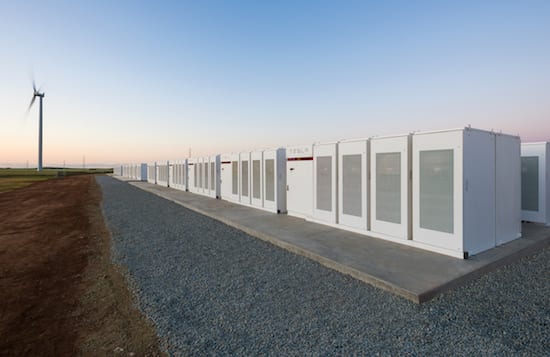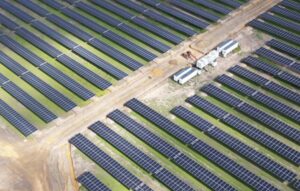Big batteries or ‘grid-scale’ batteries are a versatile, cost competitive and exciting new technology changing the landscape of Australia’s electricity grid. A big battery is made up of rows of chemical (usually lithium ion) batteries installed together and connected to the grid via inverters.
Big batteries are often located near a renewable energy generator as they help smooth out the variable output of wind and solar. They provide an instant response when there is an imbalance in the supply or demand of electricity on the network by storing or releasing large amounts of power.
Big batteries can supply electricity that can power thousands of homes for a matter of hours or days, depending upon their size.
Big batteries also play an important and cost effective role in stabilising the grid, by keeping the frequency and voltage at levels that ensure the safe supply of electricity to consumers, avoiding disconnections and blackouts.
Case study: Tesla’s pioneering big battery in South Australia
Elon Musk made plenty of news back in 2017 when Tesla built what was then the world’s largest lithium ion battery in South Australia. Officially known as the Hornsdale Power Reserve, it was located next to the Hornsdale wind farm complex north of Adelaide and had a capacity of 100MW/129MWh – enough to power 45,000 homes for about an hour.
It was built in less than 100 days at a cost of $90 million and, remarkably, in its first two years saved more than $150 million in costs to energy consumers. How? By stabilising the grid and keeping it going through extreme events; and by storing cheap renewable power when demand is low and dispatching it when demand is high.
The Hornsdale battery has now been expanded to 150MW/194MWh with a view to delivering what is traditionally known as ‘inertia’ to the grid. This means it rides through disturbances on the grid and reduces the need to keep operating expensive gas ‘peaking plants’ periodically. It will also fast track the state’s grid from 50% renewables to over 100% – all the while bringing down power prices for South Australian consumers.
The Tesla big battery was such a success that there are now a multitude of large-scale battery projects planned or in development in Australia. See: Big Battery Storage Map of Australia
Batteries allow for more renewable energy use
Since 2010, 12 ageing coal power stations in the National Electricity Market network have retired, with 18 left operating. We need to replace them with renewable sources of energy but the fluctuating supply of wind and solar power means it’s not always available when energy users need it.
Coupling big batteries with renewable energy generation means excess energy can be stored when demand is low, and released when demand is high – enabling more renewable energy to be traded and used at times when the sun isn’t shining or the wind isn’t blowing.
Batteries help maintain the balance in supply and demand
The grid must always operate with supply and demand in balance. If not, power plants will go offline in a cascading effect causing a blackout.
The grid operator AEMO forecasts how much power Australian consumers need every five minutes and then matches that with electricity generation to balance supply and demand in the grid. But AEMO can’t always predict what will happen.
In addition to the variable nature of solar and wind energy supply, there are a number of reasons why supply or demand might suddenly change: an ageing coal-fired generator might fail; a storm may damage major transmission towers, preventing power from getting to where it needs to be; or a large energy consumer might experience a fault, disconnect from the grid and reduce demand.
When electricity supply suddenly doesn’t meet demand, peaking power plants are called upon to quickly deliver the shortfall. This could be pumped hydro, gas-fired plants or big batteries.
While gas and hydro plants can deliver sustained power to meet the shortfall in a matter of minutes, the critical advantage of big batteries over these is their rapid response and flexibility – they can be turned on or off in a fraction of a second, and repeatedly without damage.
Other power plants like gas peakers are not as quick to respond, they suffer wear and tear from being turned on and off regularly, and they’re more costly to run.
Conversely, when supply outstrips demand (eg. a large energy user like a smallgoods factory with lots of refrigeration goes offline) batteries in the local grid are able to almost instantly absorb the dangerous overload, and restore the balance.
Big batteries manage frequency
Our electricity grid operates safely at a frequency of 50 Hz, when electricity supply and demand are perfectly matched. But frequency rises when the supply is in excess, and it drops when demand outstrips supply.
It is AEMO’s job to manage the frequency balancing act on the grid, maintaining the ‘inertia’ in the system by paying power generators and large consumers to act through the Frequency Control Ancillary Market (FCAS).
Inertia in the grid allows it to cope with system disturbances and keep going. More inertia means there is more time available to respond, react and counter a disturbance.
Big batteries are clever, thanks to the smart inverters that connect them to the grid. Inverters convert the power from the wind or solar farm from Direct Current (DC) to Alternating Current (AC) which is usable on the grid.
These inverters can be programmed to rapidly respond to fluctuations in frequency and voltage on the grid by charging and discharging. They are precise, versatile and cheap to operate.
Big batteries are out competing coal generators in the FCAS market. Coal plants can only supply frequency control through an inertial response for 3-6 seconds but a big battery can instantaneously, and cost effectively deliver and maintain this control until it runs out of energy.
Big batteries are cost effective
The automotive industry’s race to build electric vehicles with smaller, cheaper and more powerful lithium ion batteries has led to falling prices and improved technology for big batteries.
Big batteries are simple and quick to install, cheap to operate and respond more rapidly to disturbances on the grid that traditional peaking plants like open cycle gas generators can.
According to research by the Clean Energy Council which compared the costs of a new 250MW gas fired generator with those of a 250MW big battery project, the battery could deliver peaking services as much as 30 per cent cheaper, based on current technology prices.
Traditional peaking generators are more costly to run, they lay idle for most of the year and make most of their revenue but taking advantage of the brief periods throughout the year when wholesale electricity prices are sky high.
It is technology that enables revolutions. The Romans were able to build stronger, more expansive buildings, bridges, roads and aqueducts thanks to their masterful use of the arch, which spread loads downwards and out. Likewise, the masterful employment of big batteries in our new energy grid is a also key to spreading and balancing electricity loads, and enabling the expansion of renewable energy.










